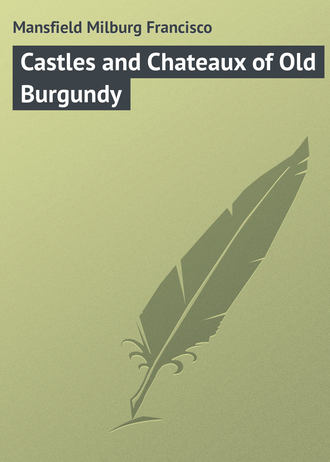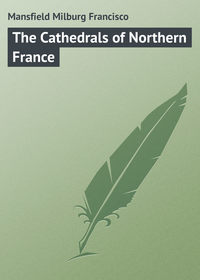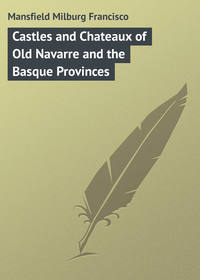 полная версия
полная версияCastles and Chateaux of Old Burgundy
The sparse population of the place were benefited by special privileges from the earliest times and the cité movenageuse itself was endowed with many admirable examples of administrative and domestic architecture.
Of the Renaissance chateaux of the later seigneurs, here and there many portions remain built into other edifices, but there is no single example left which, as a whole, takes definite shape as a noble historical monument. There are a dozen old Renaissance house-fronts, with here and there a supporting tower or wall which is unquestionably of mediæval times and might tell thrilling stories could stones but speak.
In Renaissance annals Montréal was celebrated by the exploit of the Dame de Ragny (1590), who recaptured the place after it had been taken possession of by the Ligeurs during the absence of her husband, the governor.
At the entrance of the old bourg is a great gateway which originally led to the seigneurial enclosure. It is called the Port d’en Bas and has arches dating from the thirteenth century. Montréal and its Mediæval chateau was the cradle of the Anseric-de-Montréal family, who were dispossessed in 1255 to the profit of the Ducs de Bourgogne. It was to the cadet branch of this same family Chastellux once belonged.
To the west lies Vezelay, one of the most remarkable conglomerate piles of ancient masonry to be seen in France to-day. It was a most luxurious abode in mediæval times, and its great church, with its ornate portal and façade, ranks as one of the most celebrated in Europe.
Vezelay is on no well-worn tourist track; it is indeed chiefly unknown except to those who know well their ecclesiastical history. It was within this famous church that Saint Bernard awakened the fervour of the Crusade in the breast of Louis-le-Jeune. The abbey church saw, too, Philippe-Auguste and Richard Cœur-de-Lion start for their Crusades, and even Saint Louis came here before setting out from Aigues Mortes for the land of the Turk. This illustrious church quite crushes anything else in Vezelay by its splendour, but nevertheless the history of its other monuments has been great, and the part played by the miniscule city itself has been no less important in more mundane matters. Its mediæval trading-fairs were famous throughout the provinces of all France, and even afar.
In the middle ages Vezelay had a population of ten thousand souls; to-day a bare eight hundred call it their home town.
The seigneurial chateau at Vezelay is hardly in keeping to-day with its former proud estate. One mounts from the lower town by a winding street lined on either side by admirably conserved Renaissance houses of an unpretentious class. The chateau, where lodged Louis-le-Jeune, has embedded in its façade two great shot launched from Huguenot cannon during the siege of 1559. Another seigneurial “hôtel privée” has over its portal this inscription:
“Comme Colombe humble et simple serayEt à mon nom mes mœurs conformeray.”Here in opulent Basse-Bourgogne, where the vassals of a seigneur were often as powerful as he, their dwellings were frequently quite as splendid as the official residence of the overlord. It is this genuinely unspoiled mediæval aspect of seemingly nearly all the houses of this curious old town of Vezelay which give the place its charm.
The Porte Neuve is a great dependent tower which formerly was attached to the residence of the governor – the chateau-fort in fact – and it still stands militant as of old, supported on either side by two enormous round towers and surmounted by a machicoulis and a serrated cornice which tells much of its efficiency as a mediæval defence. To the right are still very extensive remains of the fourteenth and fifteenth century ramparts.
Near Vezelay is the Chateau de Bazoche, which possesses a profound interest for the student of military architecture in France by reason of its having been the birthplace of Maréchal Vauban, who became so celebrated as a fortress-builder that he, as much as anybody, may be considered the real welder of modern France. Vauban’s body is buried in the local churchyard, but his heart had the distinction of being torn from his body and given a glorious (?) burial along with countless other fragments of military heroes in the Hotel des Invalides at Paris.
Bazoches is not a name that is on the tip of the tongue of every mentor and guide to French history, though the appearance of its chateau is such that one wonders that it is not more often cited by the guide-books which are supposed to point out the quaint and curious to vagabond travellers. There are many such who had rather worship at a shrine such as this than to spend their time loitering about the big hotels of the flash resorts with which the Europe of the average tourist is becoming overcrowded. Makers of guide-books and the managers of tourist agencies do not seem to know this.
Bazoches is a townlet of five hundred inhabitants, and not one of them cares whether you come or go. They do not even marvel that the chateau is the only thing in the place that ever brings a stranger there, – they ignore the fact that you are there, so by this reckoning one puts Bazoches, the town and the chateau, down as something quite unspoiled. Half the population lives in fine old Gothic and Renaissance houses which, to many of us, used to living under another species of rooftree, would seem a palace.
What the Chateau de Bazoches lacks in great renown it makes up for in imposing effect. Each angle meets in a svelt round tower of the typical picture-book and stage-carpenter fashion. Each tower is coiffed with a peaked candle-snuffer cap and a row of machicoulis which gives the whole edifice a warlike look which is unmistakable. The finest detail of all is “La Grande Tour” supporting one end of the principle mass of the chateau, and half built into the hillside which backs it up on the rear. Vauban bought an old feudal castle in 1663 and added to it after his own effective manner, thus making the chateau, as one sees it to-day, the powerful bulwark that it is.
The chateau belongs to-day to the Vibrave family, who keep open house for the visitor who would see within and without. The principle apartment is entirely furnished with the same belongings which served Vauban for his personal use.
Another neighbouring chateau, bearing also the name Chateau de Vauban, was also the property of the Maréchal. It dates from the sixteenth century, and though in no way historic, has many architectural details worthy of observation and remark.
CHAPTER IV
SEMUR-EN-AUXOIS, ÉPOISSES AND BOURBILLY
DUE east from Avallon some thirty odd kilometres is Semur-en-Auxois. It is well described as a feudal city without and a banal one within. Its mediæval walls and gates lead one to expect the same old-world atmosphere over all, but, aside from its churches and an occasional architectural display of a Renaissance house-front, its cast of countenance, when seen from its decidedly bourgeois point of view, is, if not modern, at least matter-of-fact and unsympathetic.
In spite of this its historical recollections are many and varied, and there are fragments galore of its once proud architectural glories which bespeak their prime importance, and also that the vandal hand of so-called progress and improvement has fallen heavily on all sides.
The site of Semur to a great extent gives it that far-away mediæval look; that, at least, could not be taken away from it. It possesses, moreover, one of the most astonishing silhouettes of any hill-top town in France. Like Constantine in North Africa it is walled and battlemented by a series of natural defences in the form of ravines or gorges so profound that certainly no ordinary invading force could have entered the city.
Semur was formerly the capital of the Auxois, and for some time held the same rank in the Burgundian Duchy.
The city from within suggests little of mediævalism. Prosperity and contentment do not make for a picturesque and romantic environment of the life of the twentieth century. It was different in the olden time. Semur, by and large, is of the age of mediævalism, however, though one has to delve below the surface to discover this after having passed the great walls and portals of its natural and artificial ramparts.
Semur’s bourg, donjon and chateau, as the respective quarters of the town are known, tell the story of its past, but they tell it only by suggestion. The ancient fortifications, as entire works, have disappeared, and the chateau has become a barracks or a hospital. Only the chateau donjon and immediate dependencies, a group of towering walls, rise grim and silent as of old above the great arch of the bridge flung so daringly across the Armançon at the bottom of the gorge.
The last proprietor of Semur’s chateau was the Marquis du Chatelet, the husband of the even more celebrated Madame du Chatelet, who held so great a place in the life of Voltaire. The philosopher, it seems, resided here for a time, and his room is still kept sacred and shown to visitors upon application.
Semur as much as anything is a reminder of the past rather than a living representation of what has gone before. Within the city walls were enacted many momentous events of state while still it was the Burgundian capital. Again during the troublous times of the “Ligue,” Henri IV transferred to its old chateau the Parliament which had previously held its sittings at Dijon.
Semur’s monuments deserved a better fate than has befallen them, for they were magnificent and epoch-making, if not always from an artistic point of view, at least from an historic one.
We made Semur our headquarters for a little journey to Époisses, Bourbilly and Montbard, where formerly lived and died the naturalist Buffon, in the celebrated Chateau de Montbard.
Époisses lies but a few kilometres west of Semur. Its chateau is a magnificently artistic and historic shrine if there ever was such. In 1677 Madame de Sévigné wrote that she “here descended from her carriage: chez son Seigneur d’Époisses.” Here she found herself so comfortably off that she forgot to go on to Bourbilly, where she was expected and daily awaited. It was ten days later that she finally moved on; so one has but the best of opinions regarding the good cheer which was offered her. At the time it must have been an ideal country house, this mansion of the Seigneur d’Époisses, as indeed it is to-day. The lady wrote further: “Here there is the greatest liberty; one reads or walks or talks or works as he, or she, pleases.” This is what everyone desires and so seldom gets when on a visit. As for the other natural and artificial charms which surrounded the place, one may well judge by a contemplation of it to-day.
Here in the chateau, or manor, or whatever manner of rank it actually takes in one’s mind, you may see the room occupied by Madame de Sévigné on the occasion of her “pleasant visit.” It is a “Chambre aux Fleurs” in truth, and that, too, is the name by which the apartment is officially known.
Above the mantel, garlanded with flowers carved in wood, one reads the following attributed to the fascinating Marquise herself. The circumstance is authenticated in spite of the fantastic orthography. As a letter writer, at any rate, she made no such faults.
“Nos plaisirs ne sont capparenceEt souvent se cache nos pleursSous l’éclat de ces belles fleursQui ne sont que vaine éperance.”The Chateau de Bourbilly, where Madame de Sévigné was really bound at the time she lingered on “chez son cher seigneur,” is a near neighbour of Époisses. It was the retreat of Madame de Chantal, the ancestress of Madame de Sévigné, the founder of the Order of the Visitation who has since become a saint of the church calendar – Sainte Jeanne-de-Chantal.
This fine seventeenth century chateau, with its pointed towers and its mansard, belonged successively to the families Marigny, de Mello, de Thil, de Savace, de la Tremouille and Rabutin-Chantel, of which the sanctified Jeanne and Madame de Sévigné were the most illustrious members.
Madame de Sévigné, the amiable letter writer, sojourned here often on her voyages up and down France. She herself lived in the
Chateau des Rochers in Brittany and her daughter, the Comtesse de Grignan, in Provence, and they did not a little visiting between the two. Bourbilly was a convenient and delightful halfway house.
Madame de Sévigné can not be said to have made Bourbilly her residence for long at any time. For a fact she was as frequently a guest at the neighbouring Chateau de Guitant, a feudal dwelling still inhabited by the de Guitants, or at Époisses, as she was at Bourbilly.
In the chapel, which is of the sixteenth century, is the tomb of the Baron de Bussy-Rabutin and some reliques of Sainte-Jeanne-de-Chantal. The latter has served to make of Bourbilly a pilgrim shrine which, on the 21st August, draws a throng from all parts for the annual fête.
There was a popular impression long current among French writers that Madame de Sévigné was born in the Chateau de Bourbilly. A line or two of that indefatigable penman, Bussy, tended to make this ready of belief when he wrote of his cousin as “Une demoiselle de Bourgogne egarée en Bretagne.” She herself claimed to have been “transplanted,” but it was a transplantation by marriage; she was most certainly not born at Bourbilly, at any rate, for history, better informed than an unconvincing scribbler, states that she was born in Paris, like Molière and Voltaire, who also have finally been claimed by the capital as her own.
At all events, at Bourbilly Madame de Sévigné was true enough on the land of the “vieux chateau de ses pères, ses belles prairies, sa petite rivière, ses magnifiques bois.” It was her property in fact, or came to be, and she might have lived there had she chosen. She would not dispose of it when importuned to do so, and replied simply, but coldly (one reads this in the “Letters”), “I will not sell the property for the reason that I wish to hand it down to my daughter.” From this one would think that she had a great affection for it, but at times it was a “vieux chateau” and at others it was a “horrible maison.” Capricious woman! The letters of Madame de Sévigné written from here were not numerous, as she only “stopped over” on her various journeyings. When one recognizes the tastes and habits of the Marquise, it is not to be wondered at that her visits to Bourbilly were neither prolonged nor multiplied.
Turning one’s itinerary south from Semur one comes shortly to Cussy-la-Colonne, where “la Colonne” is recognized by the archæologists as one of the most celebrated and most ancient monuments of Burgundy.
One learns from the inscription in Franco-Latin that the ancient monument (antiquissimum hoc monumentum) much damaged by the flapping wings of time, was rebuilt, as nearly as possible in its original form, by a prefect of the Department of the Côte d’Or (Collis Aurei Praefectus), M. Charles Arbaud, in the reign (sous l’empire) of Charles X (imperante Carolo X… Anno Salutis MDCCCXXV.) An astonishing mélange this of the tongue of Cicero and modern administrative patois.
The Colonne de Cussy, is rather a pagan memorial of a victory of the Romans in the reign of Diocletian, or, from another surmise, a funeral monument to a Roman general dead on the eve of victory. In either case, there it stands fragmentary and wind and weather worn like the pillars of Hercules or Pompey.
One simply notes Cussy and its “colonne” en passant on the road to Saulieu and Arnay-le-Duc, where the Ducs de Bourgogne had one of their most favoured country houses, or manors.
We only stopped at Saulieu by chance anyway; we stopped for the night in fact because it was getting too late to push on farther, and we were glad indeed that we did.
Saulieu is a most ancient town and owes its name to a neighbouring wood. Here was first erected a pagan temple to the sun; fragments of it have recently been found; and here one may still see the tracings of the old Roman way crossing what was afterwards, – to the powerful colony at Autun, – the Duchy of Burgundy.
As a fortified place Saulieu was most potent, but in 1519 a pest destroyed almost its total population. Disaster after disaster fell upon it and the place never again achieved the prominence of its neighbouring contemporaries.
It was here at Saulieu in Revolutionary times that the good people, as if in remembrance of the disasters which had befallen them under monarchial days, hailed with joy the arrival of the men of the Marseilles Battalion as they were marching on Paris “to help capture Capet’s castle.” Before the church of Saint Saturnin the Patriots’ Club had lighted a big bonfire, and the “Men of the Midi” were received with open arms and a warm welcome.
“How good they were to us at Saulieu,” said one of the number, recounting his adventures upon his arrival at Paris; “they gave us all the wine we could swallow and all the good things we could eat, – we had enough bœuf-à-la-daub to rise over our ears…”
To-day the good folk of Saulieu treat the stranger in not unsimilar fashion, and though the town lacks noble monuments it makes up for the deficiency in its good cheer. Saulieu in this respect quite lives up to its reputation of old. This little capital of the Morvan-Bourguignon has ever owned to one or more distinguished Vatel’s. Madame de Sévigné, in 1677, stopped here at a friend’s country house, and, as she wrote, “le fermier donne à tous un grand diner.” This was probably the Manoir de Guitant between Bourbilly and Saulieu. They were long at table, for it was a diner des adieux given by her friend Guitant to his visitors. She wrote further: “With the dinner one drank a great deal, and afterwards a great deal more; all went off with the greatest possible éclat. Voila l’affaire!”
Evidently such a manner of parting did not produce sadness!
A donjon tower with a duck-pond before it, opposite the Hotel de la Poste is all the mediævalism that one sees within the town at Saulieu to-day. It is all that one’s imagination can conjure up of the ideal donjon of mediævalism and interesting withal, though its history is most brief, indeed may be said to exist not at all in recorded form, for the chief references to Saulieu’s historic past date back to the pagan temple and the founding of the Abbey of Saint Andoche in the eighth century.
Still heading south one comes in a dozen kilometres to a chateau of the fourteenth century, and the restorations of Henri IV at Thoisy-la-Berchere. Later restorations, by the Marquis de Montbossier, who occupies it to-day, have made of it one of the most attractive of the minor chateaux of France. One may visit it under certain conditions, whether the family is in residence or not, and will carry away memories of many splendid chimney pieces and wall tapestries. For the rest the furnishings are modern, which is saying that they are banal. This of course need not always be so, but when the Renaissance is mixed with the art nouveau and the latest fantasies of Dufayal it lacks appeal. This is as bad as “Empire” and “Mission,” which seem to have set the pace for “club furniture” during the past decade.
Arnay-le-Duc still to the south was the site of a ducal Burgundian manor which almost reached the distinction of a palace. Here the country loving dukes spent not a little of their leisure time when away from their capital.
Arnay-le-Duc, more than any other town of its class in France, retains its almost undefiled feudal aspect to-day when viewed from beyond the walls. Formerly it was the seat of a bailliage and has conserved the débris of the feudal official residence. This is supported in addition by many fine examples of Renaissance-Burgundian architectural treasures which give the town at once the stamp of genuineness which it will take many years of progress to wholly eradicate.
None of these fine structures, least of all the ducal manor, is perfectly conserved, but the remains are sufficiently ample and well cared for to merit the classification of still being reckoned habitable and of importance. The old manor of the dukes has now descended to more humble uses, but has lost little of the aristocratic bearing which it once owned.
It was near this fortified bourgade of other days – fortified that the dukes might rest in peace when they repaired thither – that the infant Henri IV, at the age of sixteen, received his baptism of fire and first gained his stripes under the direction of Maréchal de Cossé-Brissac.
CHAPTER V
MONTBARD AND BUSSY-RABUTIN
MONTBARD lies midway between Semur and Châtillon-sur-Seine, on the great highroad leading from Burgundy into Champagne. The old Chateau de Montbard is represented only by the donjon tower which rises grimly above the modern edifice built around its base and the sprawling little town which clusters around its park gates at the edge of the tiny river Brenne.
The “grand seigneur” of Montbard was but a simple man of letters, the naturalist Buffon. Here he found comfort and tranquillity, and loved the place and its old associations accordingly. Here he lived, “having doffed his sword and cloak,” and occupied himself only with his literary labours, though with a gallantry and esprit which could but have produced the eloquent pages ascribed to him.
Buffon was a native of the town, and through him, more than anyone else, the town has since been heard of in history.
Having acquired the property of the old chateau, the donjon of which stood firm and broad on its base, he made of the latter his study, or salon de travail. This is the only remaining portion of the mediæval castle of Montbard. The ancient walls which existed, though in a ruined state, were all either levelled or rebuilt by Buffon into the dependent dwelling which he attached to the donjon. The Revolution, too, did not a little towards wiping out a part of the structure, as indeed it did the tomb of the naturalist in the local churchyard.
Buffon, or, to give him his full title, Georges-Louis-Leclerc-de-Buffon lived here a life of retirement, amid a comfort, perhaps even of luxury, that caused his jealous critics to say that he worked in a velvet coat, and that he was a sort of eighteenth century “nature-fakir.” This is probably an injustice.
In 1774 Louis XV made the “terre de Buffon” a countship, but the naturalist chose not to reside in the village of the name, but to live at Montbard some leagues away.
Montbard’s actual celebrity came long before the time of Buffon, for its chateau was built in the fourteenth century and was for centuries the possessor of an illustrious sequence of annals intimately associated with the dukedom of Burgundy.
Jean-Sans-Peur, it is to be noted, passed a portion of his youth within its walls. This gives it at once rank as a royal chateau, though that was not actually its classification. The Princesse Anne, sister of Philippe le Bon, here married the Duke of Bedford in 1423. All this would seem fame enough for Montbard, but the local old men and women know no more of their remote rulers than they do of Buffon; local pride is a very doubtful commodity.
It is disconcerting for a stranger to accost some bon homme or bonne femme to learn the way to the Chateau de Buffon, and to receive in reply a simple stare and the observation, “I don’t know the man.” Aside, to some crony, you may hear the observation, “Who are these strangers and what do they want with their man Buffon anyway?” This may seem an exaggeration, but it is not, and furthermore the thing may happen anywhere. Glory is but as smoke, and local fame is often an infinitesimal thing. Vanitas vanitatum et omnia vanitas!
Buffon wrote his extensive “Histoire Naturelle” at Montbard. It created much admiration at the time. To-day Buffon, his work and his chateau are all but forgotten or ignored, and but few visitors come to continue the idolatry of Jean Jacques Rousseau, who kissed the “seuil de la noble demure.”
Not long since, within some few years at any rate, a former friend of Alfred de Musset quoted some little known lines of the poet on this “berceau de la histoire naturelle,” with the result that quite recently the local authorities, in establishing the Musée Buffon, have caused them, to be carved on a panel in the naturalist’s former study at the chateau.











